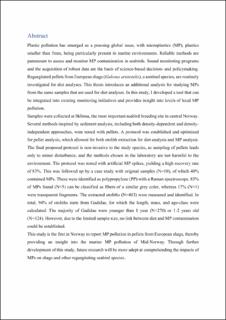| dc.description.abstract | Abstract
Plastic pollution has emerged as a pressing global issue, with microplastics (MP), plastics smaller than 5mm, being particularly present in marine environments. Reliable methods are paramount to assess and monitor MP contamination in seabirds. Sound monitoring programs and the acquisition of robust data are the basis of science-based decision- and policymaking. Regurgitated pellets from European shags (Gulosus aristotelis), a sentinel species, are routinely investigated for diet analyses. This thesis introduces an additional analysis for studying MPs from the same samples that are used for diet analyses. In this study, I developed a tool that can be integrated into existing monitoring initiatives and provides insight into levels of local MP pollution.
Samples were collected at Sklinna, the most important seabird breeding site in central Norway. Several methods inspired by sediment analysis, including both density-dependent and density- independent approaches, were tested with pellets. A protocol was established and optimized for pellet analysis, which allowed for both otolith extraction for diet analysis and MP analysis. The final proposed protocol is non-invasive to the study species, as sampling of pellets leads only to minor disturbance, and the methods chosen in the laboratory are not harmful to the environment. The protocol was tested with artificial MP spikes, yielding a high recovery rate of 83%. This was followed up by a case study with original samples (N=10), of which 40% contained MPs. These were identified as polypropylene (PP) with a Raman spectroscope. 83% of MPs found (N=5) can be classified as fibers of a similar grey color, whereas 17% (N=1) were transparent fragments. The extracted otoliths (N=403) were measured and identified. In total, 94% of otoliths stem from Gadidae, for which the length, mass, and age-class were calculated. The majority of Gadidae were younger than 1 year (N=270) or 1-2 years old (N=124). However, due to the limited sample size, no link between diet and MP contamination could be established.
This study is the first in Norway to report MP pollution in pellets from European shags, thereby providing an insight into the marine MP pollution of Mid-Norway. Through further development of this study, future research will be more adept at comprehending the impacts of MPs on shags and other regurgitating seabird species. | |
